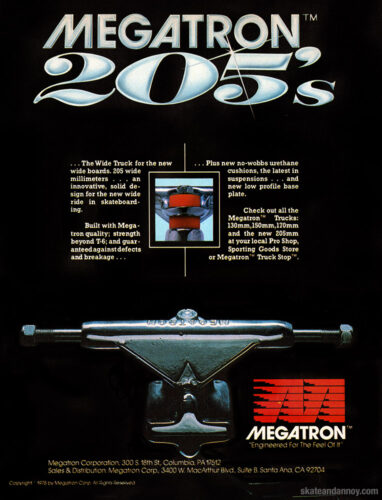
By Kent Dahlgren Originally written 8/8/04.
This article was originally posted on Sleestak.net, which closed it’s doors in spring of 2005. It may reappear on the Skaters For Public Skateparks (SPS) web site in the DIY forum, who knows. In any case, thanks to Kent Dahlgren and Bobcat at Sleestak for lettingthis article live on at Skate and Annoy. The pictures are all poached, byt the way. Some from HowStuffWorks.com. If anyone has some original pictures that we can use instead, by all means, send ’em in. Feel free to contact us and chip in with your own advice.
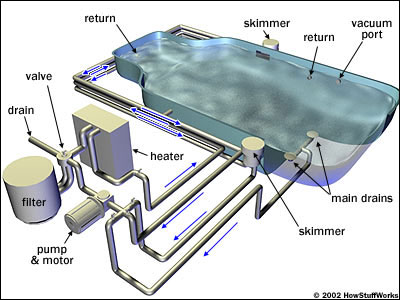
Swimming pools have plumbing. We skaters need to learn how to use this plumbing to free these pools of pesky water. Here’s a quick and dirty for those who haven’t yet learned.
The pump and all those pipes function to keep the pool clean. Water is typically sucked through the deathboxes, into pipes, through the filter, and back into the pool. In many cases, the water is also pumped through a heater, on-roof pipes, or both.
First, let’s identify the key components. Go to the pumphouse. If you are a skater…indeed, if you are a swimmer, you know what the pumphouse is. Go there. Be quiet and low key. I use the light from my cell phone to get around, as to draw as little attention as possible.
Pump
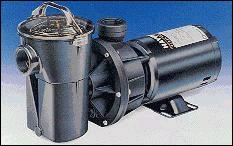
The pump itself is very simple: it’s a pump. It’s almost always on the floor and the thing to look for is a plastic screw-off lid that reveals a small “bowl,” if you will, where water from the pipes go before it enters the pump. Pay attention to this, because you’ll be using this a lot.
Filter
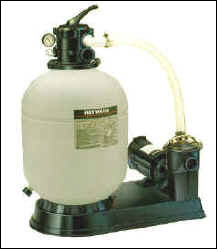
The filter is typically round, larger, and features a handle on top that goes to different settings. It’s nearly always set on “filter,” but you’ll want to set it to “waste.” Not yet, though.
Breaker box
This is what supplies power to the pump. Almost always looks like the breaker box next to your house. It should be marked for the pump, but you may have to do some trial and error. Also, if there is no power being supplied to the breaker box, then you’ll have to use alternative means to drain the pool, meaning, what I’ll describe here isn’t going to work unless you have power.
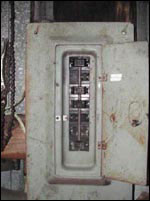
Another note: remember that you’ll almost always be standing in water, in the middle of the night, futzing with the breaker box. Think: electrocution. I just had it happen to me three nights ago. As quiet as I was trying to be, a few chickawatts and I was involentarily emptying all air through my vocal chords. Must have sounded terrible. I went from feeling elated to feeling like I hadn’t eaten in like 2 weeks. Electrocution is bad.
The rest of that stuff is BS, for what we intend to do, so you can probably ignore it.
1. Turn off the pump
If the pump is on, turn it off by using the proper breaker in the breaker box. Trial and error if necessary.
2. Close all pipes into the pump, except the main drain
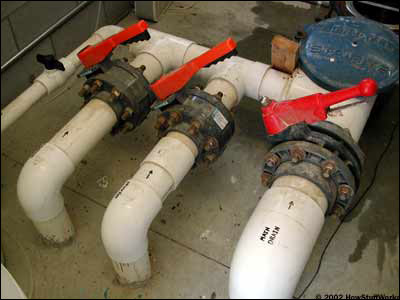
Ever skate a bowl and slam because your wheels hit the thing in the deepest part of the bowl? That’s the drain, and it’s there for a reason. In pool nomenclature, this is the “main drain,” and it’s there so people can drain the pool.
Often there are at least two pipes coming into the pump, sometimes three, depending on the size of the bowl. They may or may not be marked. I’ve seen “MD” and “SD” marked on the pipes, meaning, “Main Drain” and “Shallow Drain.” Shallow Drain is the death box.
Regardless of what it’s called, you want to identify the main drain pipe, and turn it on. Turn the rest off.
3.) Prime the pump
Unscrew the clear top to the pump (see photo above – note the pump has a plastic lid). Fill it with water. You will probably have to do this several times, so get used to it. Fill it with water, then screw the top as tightly as you can.
4.)Turn the pump on
Back to the breaker box. Mind your fingers and feet.
Note that until you see continuous flow of water through the clear top of the pump, you’ll need to repeat steps 3 and 4. But once you have a lot of flow, then you know the pool is draining.
One final note. Well, two:
- Check where the water is going
Make sure no one’s basement isn’t filling with water. Bust alert. We did that in East Portland one time. Ended up putting a couple inches of water in the neighbor’s basement. He was bummed. - Turn the pump off when the pool is empty
This comes from the “take only photos, leave nothing but aluminum” philosophy. Don’t fuck up people’s property anymore than you have to to skate a bowl.
The pump and all those pipes function to keep the pool clean. Water is typically sucked through the deathboxes, into pipes, through the filter, and back into the pool. In many cases, the water is also pumped through a heater, on-roof pipes, or both.
First, let’s identify the key components. Go to the pumphouse. If you are a skater…indeed, if you are a swimmer, you know what the pumphouse is. Go there. Be quiet and low key. I use the light from my cell phone to get around, as to draw as little attention as possible.
Pump
The pump itself is very simple: it’s a pump. It’s almost always on the floor and the thing to look for is a plastic screw-off lid that reveals a small “bowl,” if you will, where water from the pipes go before it enters the pump. Pay attention to this, because you’ll be using this a lot.
Filter
The filter is typically round, larger, and features a handle on top that goes to different settings. It’s nearly always set on “filter,” but you’ll want to set it to “waste.” Not yet, though.
Breaker box
This is what supplies power to the pump. Almost always looks like the breaker box next to your house. It should be marked for the pump, but you may have to do some trial and error. Also, if there is no power being supplied to the breaker box, then you’ll have to use alternative means to drain the pool, meaning, what I’ll describe here isn’t going to work unless you have power.
Another note: remember that you’ll almost always be standing in water, in the middle of the night, futzing with the breaker box. Think: electrocution. I just had it happen to me three nights ago. As quiet as I was trying to be, a few chickawatts and I was involentarily emptying all air through my vocal chords. Must have sounded terrible. I went from feeling elated to feeling like I hadn’t eaten in like 2 weeks. Electrocution is bad.
The rest of that stuff is BS, for what we intend to do, so you can probably ignore it.
1. Turn off the pump
If the pump is on, turn it off by using the proper breaker in the breaker box. Trial and error if necessary.
2. Close all pipes into the pump, except the main drain
Ever skate a bowl and slam because your wheels hit the thing in the deepest part of the bowl? That’s the drain, and it’s there for a reason. In pool nomenclature, this is the “main drain,” and it’s there so people can drain the pool.
Often there are at least two pipes coming into the pump, sometimes three, depending on the size of the bowl. They may or may not be marked. I’ve seen “MD” and “SD” marked on the pipes, meaning, “Main Drain” and “Shallow Drain.” Shallow Drain is the death box.
Regardless of what it’s called, you want to identify the main drain pipe, and turn it on. Turn the rest off.
3.) Prime the pump
Unscrew the clear top to the pump (see photo above – note the pump has a plastic lid). Fill it with water. You will probably have to do this several times, so get used to it. Fill it with water, then screw the top as tightly as you can.
4.)Turn the pump on
Back to the breaker box. Mind your fingers and feet.
Note that until you see continuous flow of water through the clear top of the pump, you’ll need to repeat steps 3 and 4. But once you have a lot of flow, then you know the pool is draining.
One final note. Well, two:
- Check where the water is going
Make sure no one’s basement isn’t filling with water. Bust alert. We did that in East Portland one time. Ended up putting a couple inches of water in the neighbor’s basement. He was bummed. - Turn the pump off when the pool is empty
This comes from the “take only photos, leave nothing but aluminum” philosophy. Don’t fuck up people’s property anymore than you have to to skate a bowl.




